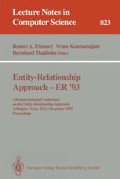Abstract
Practical extensions to the Entity-Relationship (ER) model to support inter-entity constraints, referred to as relative constraints, are described and analyzed. Relative constraints are business model integrity constraints and rules captured in the business analysis. They specify existence and value relations among predicates. The constraints are specified in a proposed declarative language based on First Order Logic. They can then be translated into the relational algebra and SQL.
Preview
Unable to display preview. Download preview PDF.
References
Ackley, D., Carasik, R., Soon, T., Tyron, D., Tsou, E., Tsur, S., and Zaniolo, C., “Systems Analysis for Deductive Database Environments: an Enhanced Role for Aggregate Entities,” Proceedings of the 9th International Conference on the Entity Relationship Approach, Lausanne, Oct. 8–10, 1990, pp. 129–142.
Baumann, Peter., “Valences: A New Relationship Concept for the Entity-Relationship Model,” Proceedings of the 8th International Conference on the Entity Relationship Approach, Toronto, Oct. 18–20, 1989, pp. 218–231.
Borgida, Alexander., “Language Features for Flexible Handling of Exceptions in Information Systems,” ACM Transactions on Database Systems, Vol. 10, No. 4, December 1985, pp. 565–603
Cazin, J., Jacquart, R., and Michel, P., “An Extension of the Entity-Relationship Model using the First Order Logic,” Proceedings of the 4th International Conference on the Entity Relationship Approach, Chicago, IEEE Computer Society Press, Silver Springs, Maryland, 1985, pp. 216–233.
Ceri, S., Gottlob, G., and Tanca, L., “What You Always Wanted to Know About Datalog (And Never Dared to Ask)”, IEEE Transactions on Knowledge and Data Engineering, Vol. 1, No. 1, March 1989.
Chen, P.P., “The Entity-Relationship Model — Toward a Unified View of Data.”, ACM Transactions on Database Systems, Vol.1, No. 1, March 1976, pp. 9–36.
Codd, E.F., “Extending the Relational Database Model to Capture More Meaning,” ACM Transactions on Database Systems, Vol. 4, No. 4, Dec. 1979, pp. 397–434.
Codd, E.F., The Relational Model for Database Management-Version 2, Addison-Wesley Publishing, 1990.
Davis, James P. and Bonnell, Ronald D., “Modeling Semantics with Concept Abstraction in the EARL Data Model”, Proceedings of the 8th International Conference on Entity Relationship Approach, Toronto, Oct. 18–20, 1989, pp. 102–117.
Hainaut, J. “A Generic Entity-Relationship Model”, IFIP 1989, Elsevier Science Publishers B. V., E.D. Falkenberg and P. Lindgreen (Editors).
Jagannathan, D., et. al., “SIM: A Database System Based on the Semantic Data Model”, ACM Publication 0-89791-268-3, 1988, pp. 46–55.
KnowledgeWare ADW Analysis Workstation User's Guide, KnowledgeWare Incorporated, 1992 [To be published].
Lazimy, Rafael., “E2R Model and Object-Oriented Representation For Data Management, Process Modeling, and Decision Support,” Proceedings of the 8th International Conference on the Entity Relationship Approach, Toronto, October 18–20, 1989, pp. 136–156.
Maier, D., Stein, J., Otis, A., Purdy, A., “Development of an Object-Oriented DBMS”, OOPSLA 1986 Proceedings, September 1986, pp.472–482.
Malhotra, A., et. al., “An Entity-Relationship Programming Language,” IEEE Transactions on Software Engineering, Vol. 15, No. 9, September 1989, pp. 1120–1130.
Oren, Olc., “Integrity Constraints in the Conceptual Schema Language SYSDOC”, Proceedings of the 4th International Conference on the Entity Relationship Approach, Chicago, IEEE Computer Society Press, Silver Springs, Maryland, 1985, pp. 288–294.
Qian, Xiaolei and Wiederhold, Gio, “Data Definition Facility of CRITIAS,” Proceedings of the 4th International Conference on the Entity Relationship Approach, Chicago, IEEE Computer Society Press, Silver Springs, Maryland, 1985, pp. 46–55.
Rochfeld, A., Morejon, J., and Negros, P., “Inter-Relationship Links in E-R Model”, Baumann, Peter., “Valences: A New Relationship Concept for the Entity-Relationship Model,” Proceedings of the 9th International Conference on the Entity Relationship Approach, Lausanne, Oct. 8–10, 1990, pp. 143–156.
Schunck, B., Laird, J.E., Durfee, E, “Course Notes: Introduction to Artificial Intelligence”, University of Michigan, Department of Electrical Engineering and Computer Science, 1989.
Shipman, David, “The Functional Data Model and te Data Language DAPLEX,” ACM Transactions on Database Systems, Vol. 6, No. 1, March 1981, pp. 140–173.
SQL Language Reference Manual, ORACLE, Version 5.1.
Su, S.Y.W. “SAM*: A Semantic Association Model for Corporate and Scientific-Statistical Databases,” Journal of Information Sciences 29, 1983, pp. 151–199.
Su, S.Y.W., Krishnamurthy, V., and Lam,H. “An Object-Oriented Semantic Association Model OSAM*,” Artificial Intelligence Manufacturing Theory and Practice, S. Kumara et al (eds.), American Institute of Indus. Engr., 1989, Chap. 17, pp. 463–494.
Sudkamp, N. and Kandzia, P., “Enforcement of Integrity Constraints in a Semantic Data Model,” CSL 88 — 2nd Workshop on Computer Science Logic Proceedings, 1989, pp. 313–328.
Teorey, T.J., Yang, D., and Fry, J.P., “A Logical Design Methodology for Relational Databases Using the Extended Entity-Relationship Model,” ACM Computing Surveys, Vol. 18, No. 2, 1986, pp. 197–222.
Teorey, T.J., Database Modeling and Design-The Entity-Relationship Approach, Morgan-Kaufmann Publishers, Inc., 1990.
Ullman, J., Principles of Database and KnowledgeBase Systems-Volume 1, Computer Science Press, 1988.
Wei, G. and Teorey, T.J., “The ORAC Model: A Unified View of Data Abstractions,” Proceedings of the 10th International Conference on the Entity Relationship Approach, San Mateo, California, USA, Oct. 23–25, 1991, pp. 31–58.
Winter, K.A., “Virtual Fact Names,” Private Communication, 1991.
Author information
Authors and Affiliations
Editor information
Rights and permissions
Copyright information
© 1994 Springer-Verlag Berlin Heidelberg
About this paper
Cite this paper
Behm, J.B., Teorey, T.J. (1994). Relative constraints in ER data models. In: Elmasri, R.A., Kouramajian, V., Thalheim, B. (eds) Entity-Relationship Approach — ER '93. ER 1993. Lecture Notes in Computer Science, vol 823. Springer, Berlin, Heidelberg. https://doi.org/10.1007/BFb0024356
Download citation
DOI: https://doi.org/10.1007/BFb0024356
Published:
Publisher Name: Springer, Berlin, Heidelberg
Print ISBN: 978-3-540-58217-5
Online ISBN: 978-3-540-48575-9
eBook Packages: Springer Book Archive

